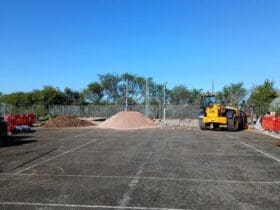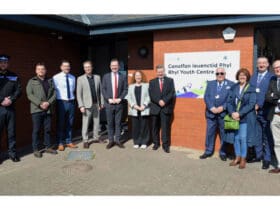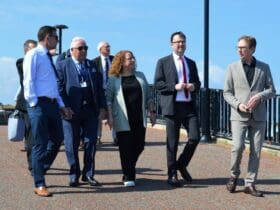A draughty and derelict barn on an historic farm built by a royal tax collector has been transformed into a luxurious holiday let thanks to the dedication of a Denbighshire woman.
And the old farm building dating back over 460 years to the reign of Elizabeth I is now warm as toast thanks to a sophisticated heating system which uses the natural warmth of the rich soil of the Vale of Clwyd.
That has been installed by award-winning Denbigh-based firm Hafod Renewables and has the added benefit of earning owner Zoë Henderson £4,000 a year income from the Renewable Heating Initiative.
Caerfallen, just north of Ruthin was built for Robert Turbridge, in 1559, the Queen’s Surveyor of North Wales which meant he collected Elizabeth’s taxes, and is now owned by Zoë whose grandfather bought it in 1955.
Zoë, a former businesswoman with American giant Dow Chemical, has transformed the old barn which was in danger of collapsing and turned it into a beautifully-appointed three bedroom-three bathroom holiday let with sweeping views across the Vale of Clwyd.
Central to the air of luxury is then underfloor heating which is fitted under the slates downstairs – slates which once lined the barn’s milking stalls – and the oak floors upstairs.
That heating is powered by heat generated by the summer sun and stored in the ground in a nearby field where sheep and Zoe’s horses now graze.
Four feet below the grass water flowing through 600 metres of pipe installed by local company Hafod Renewables is heated by the soil’s residual warmth and is fed back into the barn.
There in the boiler room is a heat exchanger capable of transforming the winter chill of ground temperatures as low as 4C to a positively tropical 35C so while outside the latest blast of Siberian air has Britain shivering, inside it’s a balmy 25C.
David Jones, Managing Director of Hafod Renewables, said:
“We have done similar work but this was such a historic property that it was pretty special.
“Zoë wanted to use renewable heating and we recommended ground source because it is cheap, efficient and easy to run and there was plenty of ideal land owned by Zoë’s father alongside the property.
“The system uses the big bank of heat that is built up in the ground by the sun through the summer and which is retained through the year, even in the hardest frosts and snow.
“Ground-source heating is half the price of oil and a third of the cost of electric so it’s a perfect solution because it’s the best value heating and Zoë will also receive a £4,000 Renewable Heat Incentive annually for seven years.”
The 12 kilowatt heating system is part of a major renovation which has saved the dilapidated barn carried out by Zoë and the Henderson family over the past five years.
She said: “My parents, David and Wendy Henderson, had farmed here for many years but it was time for them to move somewhere warm and the last thing we wanted was to sell the house and see someone else renovate it.
“The barn is a family project with my sister, Sue, and brother, Harry, as well as my parents although I bought the Caerfallen farmhouse and have started out on what is a real labour of love.
“The barn was virtually derelict and just about falling down but we have transformed it using local tradespeople and suppliers and it will be open to paying guests from May because I could do with an income from it.
“I always wanted to use renewable energy and Hafod came up with this solution and have also done all the plumbing and I’m very pleased with the result.
“I also want to thank Denbighshire County Council and their conservation architect, Phil Ebbrell now retired, from whom we got great support for our project and together all of us are hopefully leaving a legacy here.”
There has been a house on the land since at least 1324 and dendrochronology dating of the timbers carried out by Discovering Old Welsh Houses at Caerfallen date it to 1560, two years into Elizabeth I’s reign and the barn is believed to be from the same period.
It later belonged to the Ruthin Castle estate from 1661 until it was sold off in 1913 to William Godfrey Lecomber, then Mayor of Ruthin, before being bought for Kathleen and George Hooson in 1925 with Zoe’s grandfather, William Henderson, a Liverpool businessman, buying it in 1955.
The choice of ground source was a no-brainer according to David Jones, an electrician and graduate in Renewable Energy, who founded Hafod Renewables with his father, Richard, a heating engineer, in 2010.
They are experts in solar energy and have expanded into ground and air-source heat pumps, biomass and underfloor heating.
David said:
“One of the beauties of ground source heating for an important listed building like this is that it’s invisible, there aren’t any solar panels on the roof or an air-source system on the wall.
“It’s also silent so you switch it on and forget about it for 25 years while it heats your home and pays you a nice little income.”
For more on Hafod Renewables go to https://www.hafodrenewables.co.uk/








Leave a Reply
View Comments